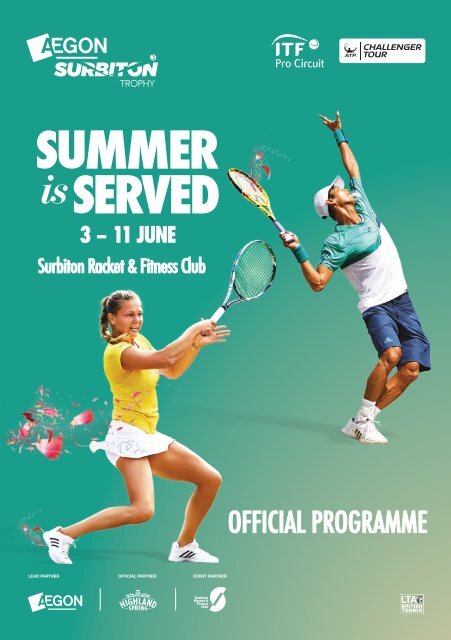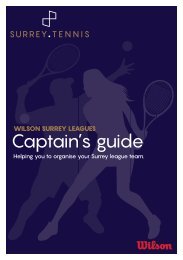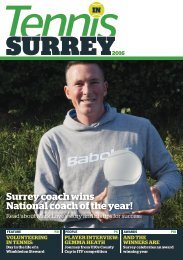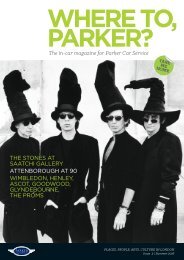Surbiton_Trophy_Programme_2017
Create successful ePaper yourself
Turn your PDF publications into a flip-book with our unique Google optimized e-Paper software.
3 – 11 JUNE<br />
<strong>Surbiton</strong> Racket & Fitness Club<br />
OFFICIAL PROGRAMME<br />
LEAD PARTNER OFFICIAL PARTNER EVENT PARTNER
Over the past nine years we have encouraged everyone to get involved in<br />
tennis. Whether that’s playing at your local park, representing your school,<br />
watching a local match or cheering on your favourite players at our major<br />
tournaments. We’ve been proud to sponsor British Tennis.<br />
See our legacy<br />
aegontennis.co.uk/legacy<br />
#9greatyears
A warm welcome to the Aegon <strong>Surbiton</strong> <strong>Trophy</strong> at<br />
<strong>Surbiton</strong> Racket & Fitness Club<br />
We are delighted to welcome you<br />
here to the <strong>Surbiton</strong> Racket and<br />
Fitness Club for the Aegon <strong>Surbiton</strong><br />
<strong>Trophy</strong> in the biggest and best ever<br />
British grass court tennis season.<br />
Last year brought us some<br />
memorable moments on these pristine grass<br />
courts. Who can forget Yen-Hsun Lu taking the<br />
men’s title after an epic tiebreaker and change of<br />
surface? Or Marina Melnikova dodging the showers<br />
to claim the women’s crown? With another strong<br />
field of players coming to <strong>Surbiton</strong> this year, we can<br />
expect to see plenty more thrilling tennis in <strong>2017</strong>.<br />
The Aegon <strong>Surbiton</strong> <strong>Trophy</strong> is one of the<br />
cornerstones of our revamped Aegon <strong>Trophy</strong> Series,<br />
in which substantial investment from ourselves<br />
and our friends at Wimbledon has created the<br />
highest-value circuit at this level in the world.<br />
Together with partner tournaments at Manchester,<br />
Nottingham, Ilkley and Southsea, <strong>Surbiton</strong> forms<br />
part of an ATP Challenger and ITF Women’s Pro<br />
Circuit calendar that is now worth over $850,000.<br />
However, this event is not just about attracting<br />
top players to the club. Not only will it offer up<br />
thrilling tennis for fans on the day, it also provides<br />
us with a golden opportunity to inspire people in<br />
the area to pick up a racket and go hit it.<br />
There are so many people to thank in the<br />
delivery of this fantastic event - the ITF, ATP, our<br />
sponsors, <strong>Surbiton</strong> Racket & Fitness Club, Surrey<br />
LTA and their volunteers, as well as all of our local<br />
volunteers.<br />
Finally, I would like to take a moment to<br />
acknowledge the incredible contribution of our<br />
lead partner Aegon. Over the nine years of our<br />
partnership they have delivered invaluable support<br />
for all levels of British Tennis with dedication and<br />
enthusiasm.<br />
I wish all of the players at this year’s Aegon<br />
<strong>Surbiton</strong> <strong>Trophy</strong> the very best of luck and hope you<br />
enjoy the world-class action they are sure to serve<br />
up this week.<br />
Martin Corrie<br />
LTA President<br />
forewords<br />
Passing on our British tennis<br />
legacy: Game, Set and Match<br />
Since 2009, we’ve been on an<br />
amazing journey as Lead Partner of<br />
British Tennis.<br />
We’ve seen the five-time winner at the Aegon<br />
Championships, Andy Murray, become world No.1,<br />
the Aegon GB Davis Cup Team become World<br />
Champions, Team Aegon’s Jo Konta break into the<br />
women’s Top 10, and our Aegon FutureStar Kyle<br />
Edmund reach the men’s top 40.<br />
Half the schools in the UK now play tennis<br />
through our Aegon Schools <strong>Programme</strong>, and we<br />
also regenerated 212 parks through our Aegon<br />
Parks Tennis <strong>Programme</strong> offering free tennis to all.<br />
We’re delighted the ladies’ $100k and men’s<br />
¤127k events make their return to the <strong>Surbiton</strong><br />
grass courts. It’s a fantastic chance for all the<br />
family to watch some great grass court tennis.<br />
Enjoy the tennis and join us in celebrating a<br />
great nine years.<br />
Adrian Grace<br />
Chief Executive, Aegon UK<br />
Aegon <strong>Surbiton</strong> <strong>Trophy</strong><br />
The tournament<br />
Tournament Director Dave Malia<br />
ITF Supervisor Carl Baldwin<br />
ATP Supervisor Stephane Cretois<br />
The club<br />
Club President Mike Carroll<br />
Club Director Roy Staniland<br />
Head Coach Tom Crisp<br />
The <strong>Programme</strong><br />
Design Anthony Collins<br />
Printed by cubiquitymedia.com<br />
The tournament would like to thank BMW for<br />
supplying the player transportation.<br />
The tournament would also like to thank the<br />
members of <strong>Surbiton</strong> Racket & Fitness Club for the<br />
use of the club, and thank you to Hollyfield School<br />
and Christchurch Primary School, <strong>Surbiton</strong>, for<br />
providing our ball crew.<br />
www.LTA.org.uk/aegonsurbitontrophy @<strong>Surbiton</strong><strong>Trophy</strong> 3
former champions<br />
our<br />
champions<br />
Many of the world’s greatest players have competed on the<br />
beautiful grass courts of <strong>Surbiton</strong> Racket & Fitness Club. But where<br />
did their lives take them after they finished playing tennis? Club<br />
President Mike Carroll looks back at some of the most interesting<br />
<strong>Surbiton</strong> champions from both the near and the distant past.<br />
4 Aegon surbiton trophy <strong>2017</strong>
Charlotte Cooper Sterry<br />
Charlotte Cooper Sterry<br />
(champion 1900, 1901, 1902, 1907, 1913)<br />
Born and brought up in west London, Sterry (née<br />
Cooper) also won Wimbledon five times during<br />
the late 1800s and early 1900s. She became the first<br />
female champion at the Olympic Games in 1900.<br />
he year was 1881. Queen Victoria was on<br />
T the throne. Picasso was born. The infamous<br />
Gunfight at the O.K. Corral took place, and the<br />
First Boer War came to an end. It was also the year<br />
this tennis club was born. Originally known as<br />
Berrylands Lawn Tennis Club, it initially had 200<br />
members, compared to the 1,500 or so we have<br />
today.<br />
By 1890 the club had staged its very first Surrey<br />
Grass Court Championships, a pre-Wimbledon<br />
tournament that has been – on and off and in<br />
various guises – an important fixture on the British<br />
tennis calendar ever since. Nowadays, of course, it’s<br />
known as the Aegon <strong>Surbiton</strong> <strong>Trophy</strong>.<br />
Many of the world’s greatest tennis players have<br />
competed in this event. Here we pick some of our<br />
favourite former champions and discover what<br />
happened to them after their success at <strong>Surbiton</strong>.<br />
Toupie Lowther<br />
(champion 1903, 1906)<br />
Tennis wasn’t Lowther’s only sporting skill. She<br />
also excelled at fencing, motoring, weight-lifting<br />
and even jujitsu. After World War I broke out<br />
in 1914 she put together an all-female squad of<br />
ambulance drivers which operated close to the<br />
front lines in northern France. In 1918 the French<br />
government awarded her the Croix de Guerre.<br />
Arthur Gore<br />
(champion 1907)<br />
Gore was already something of a legend in<br />
Edwardian tennis by the time he won here at<br />
<strong>Surbiton</strong> in 1907 since, six years previously he had<br />
captured the first of his three Wimbledon titles.<br />
And he was no spring chicken: in 1909, he was 41<br />
years old when he won Wimbledon for the third<br />
time – still the oldest men’s singles champion at<br />
the All England Club.<br />
www.LTA.org.uk/aegonsurbitontrophy @<strong>Surbiton</strong><strong>Trophy</strong> 5
former champions<br />
Dorothea Chambers<br />
(champion 1914, 1920)<br />
Chambers was already one of the greatest female<br />
players of her era by the time she took her first<br />
title at <strong>Surbiton</strong>. Between 1903 and 1914 she won<br />
a staggering seven singles titles at Wimbledon, as<br />
well as the singles at the 1908 Olympics.<br />
Cam Malfroy<br />
(champion 1936)<br />
Not long after winning at <strong>Surbiton</strong>, this New<br />
Zealand player became a decorated fighter pilot in<br />
World War II, flying Hurricanes and Spitfires. He<br />
was credited with destroying five enemy aircraft<br />
in all.<br />
Althea Gibson<br />
Helen Wills Moody<br />
(champion 1938)<br />
This Californian player won 19 Grand Slam singles<br />
titles in all, an achievement that cemented her<br />
status as a global superstar. Her graceful playing<br />
style was universally admired. Charlie Chaplin<br />
once said that watching her playing tennis was<br />
the most beautiful sight he had ever seen. Her<br />
beauty inspired many artists to produce paintings,<br />
sculptures, murals and drawings in her image.<br />
Maureen Connolly<br />
(champion 1952)<br />
Nicknamed Little Mo, this Californian player<br />
who won nine Grand Slam singles titles in the<br />
6 Aegon surbiton trophy <strong>2017</strong>
Roger Taylor<br />
Helen Wills Moody<br />
1950s, had her playing days cut cruelly short after<br />
a horse-riding accident. She then threw all her<br />
energies into a second career as a sportswriter, TV<br />
commentator, entrepreneur and coach.<br />
Althea Gibson<br />
(champion 1956, 1957, 1958)<br />
Gibson’s first <strong>Surbiton</strong> title came just days after<br />
this American player won at Roland Garros,<br />
thereby becoming the first black person to win a<br />
Grand Slam in tennis. Venus Williams once wrote<br />
in tribute to her: “I am honoured to have followed<br />
in such great footsteps. Her accomplishments set<br />
the stage for my success, and through players like<br />
myself and Serena and many others to come, her<br />
legacy will live on.”<br />
Roger Taylor<br />
(champion 1963, 1967)<br />
Yorkshireman Taylor was a key British player in<br />
the 1960s and 1970s. It was fairly early in his career<br />
when he won his first <strong>Surbiton</strong> title, a grass-<br />
www.LTA.org.uk/aegonsurbitontrophy @<strong>Surbiton</strong><strong>Trophy</strong> 7
former champions<br />
Ann Jones<br />
Sue Barker<br />
court triumph that presaged his three semi-final<br />
showings at Wimbledon several years later. Taylor<br />
was the sole British member of a group of touring<br />
professionals called the Handsome Eight.<br />
David Lloyd<br />
Ann Jones<br />
(champion 1964, 1970)<br />
Originally from Birmingham, Jones won three<br />
Grand Slam singles titles in a decade dominated<br />
by Billie Jean King and Margaret Court. Nowadays<br />
she is one of the vice-presidents at the All England<br />
Club.<br />
Judy Tegart-Dalton<br />
(champion 1968, 1971)<br />
This Australian player, who also reached the<br />
final at Wimbledon in 1968, was for many years<br />
a member at <strong>Surbiton</strong> Racket & Fitness Club. She<br />
now lives back in Australia but returns most years<br />
to <strong>Surbiton</strong> and stays with the same family that<br />
hosted her the years she won the title.<br />
Sue Barker<br />
(champion 1974)<br />
Of all the former <strong>Surbiton</strong> champions, Barker<br />
needs least in the way of introduction. Two years<br />
8 Aegon surbiton trophy <strong>2017</strong>
Wesley Moodie<br />
after her triumph at <strong>Surbiton</strong> she won the singles<br />
title at Roland Garros. Her post-tennis career as a<br />
TV sports presenter at the BBC has won her even<br />
more accolades than her tennis did.<br />
David Lloyd<br />
(champion 1978)<br />
Essex-born Lloyd learned a thing or two about<br />
resilience on the tennis court, a skill that prepared<br />
him well for an enormously successful business<br />
career during which he launched many property<br />
and leisure businesses, including the health club<br />
chain that still bears his name. He was even once<br />
chairman of Hull City AFC.<br />
Evonne Goolagong Cawley<br />
(champion 1978)<br />
Goolagong was already well established as an<br />
international champion when she won her<br />
<strong>Surbiton</strong> title. The third of eight children from an<br />
Australian Aboriginal family, she won seven Grand<br />
Slam singles titles in all between 1971 (at the age<br />
of 20) and 1980 (three years after she became a<br />
mother).<br />
Evonne Goolagong Cawley<br />
Wesley Moodie<br />
(champion 2003)<br />
This tall South African player loved <strong>Surbiton</strong> so<br />
much that, after winning the title in 2003, he<br />
moved very close to the club with his family for<br />
several years. In 2011 he retired from tennis and<br />
returned to South Africa.<br />
Brenda Schultz-McCarthy<br />
(champion 2007)<br />
Brenda’s booming serve was devastating on the<br />
grass courts of <strong>Surbiton</strong>. At one time this Dutch<br />
player (who now lives in Florida) held the female<br />
record for the world’s fastest serve.<br />
www.LTA.org.uk/aegonsurbitontrophy @<strong>Surbiton</strong><strong>Trophy</strong> 9
Aegon<br />
A lasting<br />
legacy<br />
lot has changed since Aegon joined British<br />
A Tennis as its first ever lead partner back<br />
in 2009.<br />
We’ve enjoyed Davis Cup glory, Andy Murray’s<br />
Grand Slam titles, Johanna Konta breaking into the<br />
world’s top-10, and a grass-court season going from<br />
strength to strength.<br />
Aegon has been at the forefront of British Tennis’<br />
efforts to grow the game we all love across the<br />
country. As the partnership comes to an end after<br />
nearly a decade of working together, we sat down<br />
with Aegon UK’s Head of Brand and Sponsorship,<br />
Tara McGregor-Woodhams, to look back over the<br />
company’s fondest memories of its time in tennis.<br />
“It’s tricky to pick out one highlight for us as<br />
there are so many to choose from” Tara says. “In no<br />
particular order, I’d say the Aegon Championships<br />
being named Tournament of the Year four years in a<br />
row, seeing our boys win the Davis Cup, and helping<br />
3,000 talented youngsters through the Aegon<br />
FutureStars programme rank up there among the<br />
greatest memories.”<br />
For many British Tennis fans, Tara included, the<br />
2015 Davis Cup victory will be a moment that lives<br />
long in the memory. Not since 1936 had the British<br />
topped the team tennis charts, but Leon Smith’s<br />
Aegon GB Team made history with their stunning<br />
victory over Belgium in Ghent two years ago.<br />
“It was the most amazing achievement and a team<br />
effort that had been five years in the making,” Tara<br />
says. “Leon is a brilliant captain and kept the team<br />
focused as they climbed through the divisions.<br />
“I will never forget the opening in Ghent when<br />
the curtain came down and the crowds roared.<br />
The atmosphere was utterly electric. The team’s<br />
performance was absolutely staggering. It was such a<br />
privilege to be part of history.”<br />
Glory at the elite end of the spectrum makes the<br />
headlines, but Tara says the grass roots of the game<br />
have been just as important to Aegon.<br />
“For nine years, we’ve supported Britain’s top<br />
young players through our FutureStars programme,”<br />
she adds. “It’s lovely to see our original FutureStars<br />
Jo Konta break into the women’s top 10 and Kyle<br />
Edmund make the men’s top 40.”<br />
From international glory to growing the<br />
grassroots, Aegon has been committed to British<br />
Tennis for nine years. For that we say thank you,<br />
and we are sure we will continue to see Tara and the<br />
team courtside for years to come.<br />
10 Aegon surbiton trophy <strong>2017</strong>
crosshead<br />
NEW BRITISH TENNIS<br />
TEAM MEMBERSHIP<br />
Give back to the sport you love and<br />
enjoy great benefits from just £20 *<br />
Join today at lta.org.uk/membership<br />
or visit the British Tennis<br />
Membership stand<br />
Other adult and junior price options are available. Visit the website for more details.<br />
www.LTA.org.uk/aegonsurbitontrophy @<strong>Surbiton</strong><strong>Trophy</strong> 11
technology<br />
Bird’s-eye<br />
view of the<br />
future<br />
Technology is revolutionising professional sport more than ever<br />
before. Stadium engineering, TV broadcasting and augmented<br />
reality all improve the experience for both spectators and players.<br />
Here we explore how tennis might benefit in the future.<br />
12 Aegon surbiton trophy <strong>2017</strong>
An aerial drone<br />
captures images of the<br />
All England Club.<br />
photo: skyvantage<br />
ain. When it comes to tennis, it’s the ultimate<br />
R dampener. But for how long? Given the<br />
exponential advances in roof engineeering over<br />
recent years, it wouldn’t be surprising if clubs and<br />
stadia all over the world soon started installing<br />
retractable roofs to shield players and spectators<br />
from the elements. Wimbledon, of course, is on its<br />
way to constructing a second roof (on No.1 Court).<br />
Melbourne Park already has three retractable roofs,<br />
the US Open has one, and there are also outdoor<br />
tennis stadia with retractable roofs in Shanghai,<br />
Beijing, Wuhan, Hamburg, Madrid, Halle and<br />
Tokyo. Who knows? Perhaps one day even <strong>Surbiton</strong><br />
will have one? British summer, do your worst!<br />
The way professional tennis is filmed and<br />
broadcast is all set to change drastically, too.<br />
Since it was first introduced in 2006, Hawk-<br />
Eye technology has proved to be enormously<br />
successful, adding an extra element of drama<br />
when the balls land close to the lines. Aerial video<br />
drones might soon become commonplace, too,<br />
especially at large venues where there are multiple<br />
courts to cover.<br />
Currently drones are used most effectively<br />
in sports played out across wide areas or in<br />
inaccessible places: golf, trail running, road<br />
cycling, mountain biking, rally driving, horse<br />
racing, rock climbing, surfing and sailing, for<br />
example. Thanks to the drones, TV spectators are<br />
placed right in the thick of the action – whether<br />
that’s halfway up mountains, out at sea, in the<br />
middle of the desert, or lost in the rough. But<br />
they could add an exciting element to tennis, too.<br />
Imagine a drone swooping across the entirety of<br />
<strong>Surbiton</strong> Racket & Fitness Club, giving viewers a<br />
bird’s-eye vista of all the action, and zooming in<br />
on the most intriguing matches. Much cheaper<br />
(and quieter) than hiring a helicopter to do the<br />
same job.<br />
Toby Pocock is owner of aerial filming specialists<br />
Skyvantage, based in the Surrey town of Reigate. In<br />
2015 he used his drones to take stunning aerial<br />
www.LTA.org.uk/aegonsurbitontrophy @<strong>Surbiton</strong><strong>Trophy</strong> 13
technology<br />
Firstvision has invented<br />
a video camera that<br />
slots into the chest area<br />
of a player’s shirt.<br />
The results are<br />
astounding: you see<br />
the player’s racket<br />
close-up as he<br />
strikes the ball, and<br />
as he prepares for<br />
the ball toss.<br />
photos of the All England Club. He says safety<br />
regulations currently prohibit drones operating<br />
directly above tennis tournaments packed with<br />
thousands of spectators. And just as well if you<br />
recall how, in September 2015, at the US Open, a<br />
drone operated by an amateur cameraman crashlanded<br />
into empty seating in the Louis Armstrong<br />
stadium. Fortunately no one was injured but the<br />
Italian player Flavia Pennetta, who was competing<br />
against Romania’s Monica Niculescu, said she<br />
thought it had been a terrorst attack.<br />
“A little bit scary,” she said after the match.<br />
“With everything going on in the world, I thought:<br />
‘OK, it’s over.’ If there had been spectators, it would<br />
have hit them and done a lot of damage.”<br />
Fortunately, drone technology is improving<br />
all the time. “Drones are getting smaller and<br />
more reliable,” Pocock says. “Some even feature<br />
parachutes in case the motors fail.” He believes<br />
that in a few years’ time aerial drones will be an<br />
indispensable tool for all major tennis broadcasting<br />
teams.<br />
Shirt cams are another intriguing piece of<br />
TV technology. Spanish company Firstvision has<br />
invented a tiny, unobtrusive camera that fits into<br />
the chest area of a player’s shirt, beaming out live<br />
footage. On a tennis court it allows viewers to see<br />
the court as if they were actually playing on it.<br />
The company tested their device on the courts<br />
of the Academia Sanchez-Casal, in Barcelona<br />
(Andy Murray’s old alma mater). The results are<br />
astounding: you see the player’s racket close-up as<br />
he strikes the ball, and as he prepares for the ball<br />
toss. You get an intimate view when he wipes sweat<br />
off his brow, drinks from a water bottle and pulls<br />
up his socks at change of ends. And you hear him<br />
grunting, groaning and cursing during play, more<br />
clearly than if you were his doubles partner.<br />
At professional level the results would be<br />
even more impressive. Imagine how thrilling (or<br />
frightening) it would be to face Milos Raonic’s<br />
serve, or to find yourself in between the umpire<br />
and Nick Kyrgios’s chest just as an argument kicks<br />
off – with all the accompanying sound effects. If<br />
the language gets too fruity, all you do is turn the<br />
volume down.<br />
Talking of fruity language, what about coach<br />
mikes? At Davis Cup and WTA events, where<br />
courtside coaching is permitted, why shouldn’t<br />
coaches be miked up so that spectators can<br />
14 Aegon surbiton trophy <strong>2017</strong>
Left: Hawk-Eye.<br />
Below: a virtual reality<br />
headset.<br />
eavesdrop on the conversation they have with<br />
their players? Imagine being privy to conversations<br />
between Andy Murray and Leon Smith during the<br />
Davis Cup final. Or listening in as Johanna Konta’s<br />
coach Wim Fissette analyses his protegée’s serve.<br />
Tennis player statistics is another intriguing<br />
element of the sport. Using something known<br />
as augmented reality, it should soon be possible<br />
to point your smartphone at a tennis player<br />
on the court and immediately receive all the<br />
live statistical data you could possibly want.<br />
What’s Roger Federer’s heart rate as he serves on<br />
championship point at Wimbledon? What speed<br />
did Andy Murray just bash down his serve at? Give<br />
me all the biographical details on that unknown<br />
Japanese player competing at <strong>Surbiton</strong>. Easy.<br />
Simply point your phone and press. A split second<br />
later you have the live data on your screen.<br />
Augmented reality is already used in sports such<br />
as American football, rugby, cricket, swimming, ice<br />
hockey, motor racing and snooker. It won’t be long<br />
before tennis jumps on the bandwagon.<br />
City-Insights is a London-based technology<br />
company that offers augmented reality (via<br />
Imagine a drone swooping<br />
across the entirety of <strong>Surbiton</strong><br />
Racket & Fitness Club, giving<br />
viewers a bird’s-eye vista of all<br />
the action, and zooming in on<br />
the most intriguing matches.<br />
people’s mobile phones) for visitors in museums,<br />
city centres, property, retail, universities, parks<br />
and sports venues. They recently discussed with<br />
the All England Club the possibility of offering<br />
Wimbledon spectators augmented reality<br />
features such as archive photos and video footage,<br />
statistical data on players during competition, and<br />
background stories from club groundsmen and<br />
employees.<br />
Sarah Mallock is one of the company founders.<br />
She believes that, in the future, many tennis<br />
tournaments will offer extra video, photographic,<br />
audio and analytical features through spectators’<br />
mobile phones.<br />
“The ultimate would be if you could point your<br />
phone at players in a match and watch as a second<br />
layer of information appeared on your screen,” she<br />
says. “We are unfortunately a long way from the<br />
full VR headset experience being available through<br />
the average smartphone but I am sure it is all<br />
heading that way.”<br />
It won’t be long.<br />
www.LTA.org.uk/aegonsurbitontrophy @<strong>Surbiton</strong><strong>Trophy</strong> 15
tennis surrey<br />
Surrey Tennis<br />
Surrey Tennis is the County Association that supports<br />
registered venues and coaches across the county.<br />
We work in partnership with the LTA.<br />
he LTA currently has Regional Offices, with<br />
T the LTA South East covering Surrey, along<br />
with Kent, Middlesex and Sussex. You then have<br />
County Associations that have their own County<br />
Offices, which includes Surrey Tennis.<br />
The LTA South East and Surrey Tennis work<br />
together to get more people playing tennis more<br />
often in the county. Surrey Tennis focuses on<br />
supporting and promoting competitions, venue<br />
and coach initiatives that are offered by the County<br />
Association. Whereas the LTA South East focuses on<br />
supporting and promoting LTA competitions along<br />
with national coach and venue initiatives that can<br />
benefit those in Surrey.<br />
What Surrey Tennis does<br />
Surrey Tennis focuses on advising and support<br />
in 4 key areas:<br />
Clubs and venues: supporting registered<br />
clubs and venues across the county and advising<br />
them on issues affecting their venue e.g. facilities,<br />
membership, promotion. Surrey Tennis will work<br />
closely with key partners that specialise in these<br />
areas so that we can ensure venues are getting the<br />
best support possible.<br />
Coaches: providing local support for coaches<br />
in the county. This is now primarily being done<br />
through the formation of the Surrey Coaches<br />
Group. Coaches in the county can join now, and<br />
16 Aegon surbiton trophy <strong>2017</strong>
Office team and Surrey<br />
Tennis councillors<br />
There are currently 16 councillors who are<br />
volunteers that support the delivery and<br />
operation of the 4 key areas listed above.<br />
We also have 3 full-time staff that make up<br />
the Surrey Tennis Office Team:<br />
be able to access numerous benefits including:<br />
subsidised CPD and First Aid courses, local<br />
forums where coaches can network and share<br />
best practice, subsidised offers on balls and other<br />
coaching equipment, subsidised medals and<br />
trophies.<br />
For further information please visit<br />
www.tennissurrey.org.uk/surrey-coaches-group<br />
You can also contact the group on coaches@<br />
tennissurrey.org.uk<br />
Chris Risebro – Surrey Tennis Coordinator<br />
chris.risebro@tennissurrey.org.uk<br />
Tim Sagar – Tennis Development Manager<br />
tim.sagar@tennissurrey.org.uk<br />
Lewis Woodham – Competitions<br />
Administrator<br />
competitions@tennissurrey.org.uk<br />
Office Number – 020 8487 7036<br />
Competitions run and supported<br />
by the County Association<br />
Surrey inter-club leagues and team competitions<br />
Open and Senior Postal and Junior <strong>Trophy</strong><br />
Surrey Junior Little Leagues<br />
Knock-out competitions<br />
Aegon Team Tennis Surrey<br />
Road to Wimbledon County Finals<br />
Surrey County Championships<br />
County Cup teams of all ages<br />
For all other competitions that take place in<br />
the county you need to contact the LTA South<br />
East team.<br />
Disability tennis supporting our partner,<br />
the Tennis Foundation (Britain’s leading tennis<br />
charity), in raising awareness of disability tennis<br />
across the county. Surrey Tennis is keen to support<br />
and work with those venues, coaches or volunteers<br />
who are interested in getting involved in this area<br />
of tennis. Whether it be running sessions at your<br />
venue, or reaching out to the local community<br />
groups, Surrey Tennis and The Tennis Foundation.<br />
New website<br />
Surrey Tennis has a new website where you can<br />
find out the latest tennis news happening in<br />
the county, along with the current offerings for<br />
venues, coaches, competition and disability tennis<br />
in the county. You will also find information and<br />
links to LTA initiatives, where Surrey venues or<br />
coaches may benefit.<br />
Visit www.tennissurrey.org.uk<br />
www.LTA.org.uk/aegonsurbitontrophy @<strong>Surbiton</strong><strong>Trophy</strong> 17
aegon trophy series<br />
<strong>Trophy</strong> hunting<br />
Tennis now has a British grass-court swing below the main<br />
ATP / WTA pro tours. It’s called the Aegon <strong>Trophy</strong> Series and,<br />
as a breeding ground for future star players, it’s invaluable.<br />
f you want a snapshot of the British grass<br />
I court tennis scene then the Aegon <strong>Trophy</strong><br />
Series is a wonderful place to start. Now in its third<br />
year, it runs throughout the month of June and<br />
features some of the oldest clubs, one of the newest<br />
clubs and certainly some of the most prestigious<br />
clubs in the country.<br />
Its wide geographical spread – from Ilkley in<br />
West Yorkshire, via Manchester and Nottingham,<br />
to <strong>Surbiton</strong> in the London suburbs and Southsea<br />
in Hampshire – means that tennis fans all over<br />
England can get their grass-court fix in the run-up<br />
to Wimbledon.<br />
George Donnelly is the LTA’s Tournament Lead<br />
overseeing the whole series. He explains what a<br />
great opportunity it is for both players and fans.<br />
“It’s a chance to see many international players,<br />
both male and female, ranked between 50 and 150<br />
in the world, as they prepare for Wimbledon,” he<br />
says. “Many of them at this level are the future stars<br />
of the game. Thanks to serious investment in the<br />
venues, this year they will have better facilities than<br />
before, and more prize money.” Indeed, the prize<br />
money fund for the entire series has almost tripled,<br />
rising from $300,000 in 2016 to $850,000 this year.<br />
Donnelly points out how the different events can<br />
inspire local players to take up tennis. “With five<br />
tournaments in the series now, it means we have<br />
a much better platform to showcase tennis across<br />
the UK, and encourage local people to pick up a<br />
racket and try out tennis for themselves.”<br />
The first tournament in the series, from June 3rd<br />
to 11th, is the Aegon <strong>Surbiton</strong> <strong>Trophy</strong>, at <strong>Surbiton</strong><br />
Racket & Fitness Club in south London. Here, on<br />
the club’s 11 grass courts, there will be both an ITF<br />
women’s event and an ATP Challenger for the men.<br />
Originally established all the way back in 1881, this<br />
club has quite a history. Among the tennis legends<br />
18 Aegon surbiton trophy <strong>2017</strong>
that have played here are Fred Perry, Stefan Edberg,<br />
Pat Cash, Jim Courier, Tim Henman, Boris Becker,<br />
Michael Chang, Andy Roddick and Roger Federer.<br />
From June 11th to 18th, the series moves to The<br />
Northern Lawn Tennis Club in South Manchester<br />
where its seven grass courts (two protected from<br />
rain by inflatable covers, and a further two with<br />
flat covers) will host an ITF women’s tournament.<br />
Like <strong>Surbiton</strong>, The Northern Lawn Tennis Club<br />
was also established in 1881. In its time it has<br />
been graced by many of the world’s greatest<br />
players and has hosted major Davis Cup ties. The<br />
legendary Pete Sampras won his very first grass<br />
court tournament here in 1990. Last year this<br />
tournament won the ‘event of the year’ category<br />
at the annual Manchester Sports Awards. “The<br />
quality of the club’s grass courts have often found<br />
it referred to as ‘the Wimbledon of the North’,” the<br />
LTA website states.<br />
During the same week as Manchester there is<br />
a men’s ATP Challenger at Nottingham Tennis<br />
Centre. (A WTA tournament runs alongside this<br />
but is separate to the Aegon <strong>Trophy</strong> Series.) With its<br />
13 courts, this venue near the city’s university has<br />
hosted some of the world’s very best players during<br />
its history, both in ATP and Davis Cup events.<br />
From June 17th to 25th the series then moves<br />
north to Ilkley Lawn Tennis & Squash Club. Here,<br />
the Aegon Ilkley <strong>Trophy</strong> includes a women’s ITF<br />
tournament and a men’s ATP Challenger. As well<br />
as its 12 grass courts, the club has a new clubhouse<br />
and fitness suite, opened last year as part of a £2.5<br />
million investment programme. Ilkley also won<br />
Bradford Metropolitan Event of the Year for 2016.<br />
“Established in 1880, the club occupies a unique<br />
location by the River Wharfe in very picturesque<br />
surroundings looking up to the panoramic<br />
backdrop of the world-famous Ilkley Moor,”<br />
states the LTA website. “Ilkley is a jewel of the<br />
North, situated on the edge of the Yorkshire Dales<br />
AEGON TROPHY SERIES<br />
“We want to jump-start the important<br />
summer season of participation by<br />
trying to own the month of June,” says<br />
Michael Downey, CEO of the Lawn Tennis<br />
Association. “[There is] an extensive and<br />
high-quality series of major tennis events to<br />
help inspire more people to pick up a racket<br />
and play tennis.”<br />
June 3-11<br />
Aegon <strong>Surbiton</strong> <strong>Trophy</strong> (men’s and women’s)<br />
<strong>Surbiton</strong> Racket & Fitness Club, <strong>Surbiton</strong>,<br />
KT5 8JT<br />
June 11-18<br />
Aegon Manchester <strong>Trophy</strong> (women’s)<br />
The Northern Lawn Tennis Club, West<br />
Didsbury, M20 3YA<br />
June 10-18<br />
Aegon Open Nottingham (men’s)<br />
Nottingham Tennis Centre, Nottingham, NG7<br />
2QH<br />
June 17-25<br />
Aegon Ilkley <strong>Trophy</strong> (men’s and women’s)<br />
Ilkley Lawn Tennis & Squash Club, Ilkley,<br />
LS29 9BG<br />
June 27-30<br />
Aegon Southsea <strong>Trophy</strong> (women’s)<br />
Canoe Lake Leisure, Southsea, PO4 9RG<br />
National Park. If you think Wimbledon village and<br />
put it on the edge of beautiful countryside with<br />
a true Yorkshire welcome, you will be imagining<br />
Ilkley Lawn Tennis & Squash Club.”<br />
The final series tournament, staged the week<br />
before Wimbledon starts, is the Aegon Southsea<br />
<strong>Trophy</strong>. It’s an ITF women’s event at a new venue<br />
in the Hampshire town of Southsea called Canoe<br />
Lake Leisure. There are 10 new grass courts here,<br />
as well as a brand new pavilion. Unlike the other<br />
four tournaments in the series, Southsea is free for<br />
spectators to attend. Ticket sales across the series<br />
as a whole are very healthy. Last year saw 5,200<br />
ticket sales, and Donnelly says that this year will<br />
substantially eclipse that figure.<br />
“I’m excited about the interest these events are<br />
having on a local level,” he says. “I’m confident of<br />
sell-out days at a number of events.”<br />
For information, visit www.lta.org.uk/<br />
major-events/aegon-trophy-series<br />
www.LTA.org.uk/aegonsurbitontrophy @<strong>Surbiton</strong><strong>Trophy</strong> 19
different eras<br />
The 1949/1950 British<br />
Champion Joan Hughesman.<br />
Different<br />
strokes,<br />
different eras<br />
If you stepped back in time, to <strong>Surbiton</strong> Racket & Fitness Club<br />
as it was around the time of WWII, the sport would be almost<br />
unrecognisable. Technically, tactically, physiologically, financially<br />
and culturally, it is radically different. Here, players from the 1940s<br />
have their tennis lives contrasted with modern professionals.<br />
Words: Dominic Bliss<br />
20 Aegon surbiton trophy <strong>2017</strong>
“In the 1940s the Americans<br />
used to bring their own steaks<br />
over because you couldn’t<br />
get them here because of<br />
rationing. They’d put the meat<br />
in the deep freeze at the hotel.”<br />
1947 Wimbledon doubles finalist<br />
Tony Mottram (left)<br />
Tony Mottram<br />
he rackets were wooden, the balls were white,<br />
T the clothing was modest, and the prize<br />
money was non-existent. Life for top players before<br />
tennis went professional in 1968 was radically<br />
different to today in just about every aspect you<br />
can think of: training methods, travel, prize<br />
money, diet, equipment, clothing… you name it.<br />
Here we compare the lot of modern pros to two<br />
players who competed in the 1940s – the 1947<br />
Wimbledon doubles finalist Tony Mottram (who<br />
sadly passed away last year) and the 1949/1950<br />
British champion Joan Hughesman.<br />
Training<br />
Modern pros spend almost as much time in the<br />
gym as they do on the court. Then there’s all<br />
the stretching, ice baths, massages and sports<br />
psychology. Many among the game’s elite travel<br />
with a full-time fitness expert.<br />
Andy Murray, whose fitness trainer is Matt Little,<br />
is one of the most athletic players in the world<br />
right now. His strength workout includes back<br />
squats, box jumps, lunges, split jumps, pull-ups,<br />
medicine-ball throws and core stability exercises.<br />
On the running track he does gruelling 400-metre<br />
sessions. “By the end your legs are like jelly,”<br />
he says.<br />
And his post-match ice baths are now legendary.<br />
“It’s always chilled to the right temperature, about<br />
eight degrees,” he told BBC Sport. “I do eight<br />
minutes straight. The water is moving inside the<br />
ice bath because otherwise your body starts to heat<br />
it up. I might be used to it after all this time but it’s<br />
still not nice, believe me.”<br />
Back in the days of amateur tennis, players rarely<br />
saw the inside of a gym. “In comparison to today,<br />
we did nothing. General jogging but no weights,”<br />
says Tony Mottram, the 1947 Wimbledon doubles<br />
finalist.<br />
Joan Hughesman was British champion in 1949<br />
and 1950. She says she did “no physical training at<br />
all.” “But I lived three miles away from our courts<br />
and I used to walk or run there every day,” she<br />
adds. “That kept me fit.”<br />
Match preparation<br />
Early nights, no drinking, and plenty of beauty<br />
sleep. For most top pros, life on the tour can be<br />
monastic, to say the least. Back in the 1940s,<br />
however, even at tournaments, it was quite normal<br />
to prop up the club bar until the early hours of the<br />
morning.<br />
“Tennis was very social,” says Mottram who<br />
reached the quarter-finals of Wimbledon singles<br />
in 1948. “When you packed your case you made<br />
sure you had your tennis rackets and then the next<br />
most important thing was your dinner jacket. We<br />
were expected to socialise and we did.”<br />
“If you liked parties, there were plenty of<br />
parties,” Hughesman remembers. “Some of the<br />
male players drank and gambled a lot. Especially<br />
on the French Riviera.”<br />
www.LTA.org.uk/aegonsurbitontrophy @<strong>Surbiton</strong><strong>Trophy</strong> 21
different eras<br />
Prize money<br />
Since he turned professional in 1998, Roger<br />
Federer has won over US$104 million in prize<br />
money and much, much more in endorsements<br />
and sponsorship. Forbes magazine estimates that<br />
in 2016 alone he banked $60 million thanks to<br />
various deals with Nike, Rolex, Wilson, Mercedes-<br />
Benz, Moet & Chandon, Netjets, Lindt and Credit<br />
Suisse.<br />
Compare that to Rod Laver who won all four<br />
Grand Slams in 1962 and, for his efforts, received<br />
total prize money of exactly… zero. Yes, zero,<br />
because it was before the arrival of professional<br />
tennis.<br />
In 1947, after reaching the final of the<br />
Wimbledon doubles, Mottram was awarded a £10<br />
Harrods gift voucher. “But you had to spend it on<br />
sports clothing or luxury goods,” he remembers.<br />
“You couldn’t buy food with it.”<br />
For her two victories in the British<br />
Championships, Hughesman received a £5 gift<br />
voucher each time. “It was redeemable in several<br />
shops,” she says. “Sometimes tournaments would<br />
give us money to pay hotel bills. So we’d stay in<br />
really small hotels and keep the spare money.”<br />
Anti-doping<br />
Last year the International Tennis Federation<br />
carried out just under 5,000 anti-doping tests,<br />
around 2,600 of them on urine and 2,300 on blood.<br />
But drug testing didn’t exist in tennis until<br />
1993. Back in the 1940s, the only illegal substances<br />
players had to worry about was when they tried to<br />
get through customs with an extra bottle of booze<br />
and more than their allocated amount of Golden<br />
Virginia.<br />
Diet and drink<br />
Glycogen stores, vitamin<br />
supplements, amino acids,<br />
glycaemic indices, protein shakes,<br />
urine colour charts… modern<br />
athletes take sports nutrition more<br />
seriously than ever before.<br />
Rewind the clock to the years after<br />
World War II, however, and rationing<br />
in Britain was so tight that athletes<br />
would happily eat anything they could<br />
get their hands on.<br />
“It was a question of getting what<br />
“We left Heathrow on a<br />
Stratocruiser. It was two<br />
hours to Gander in Ireland;<br />
11 to Halifax in Newfoundland;<br />
and another six and a half<br />
hours to New York.”<br />
1947 Wimbledon doubles finalist<br />
Tony Mottram<br />
food was available,” says Mottram. “There was still<br />
rationing into the 1950s. It was very plain food. In<br />
the 1940s the Americans used to bring their own<br />
steaks over because you couldn’t get them here<br />
then. They’d put the meat in the deep freeze at the<br />
hotel.”<br />
Hydration during play was barely a<br />
consideration. “It was considered bad if you drank<br />
water during matches because it might give you<br />
a stitch,” explains Mottram. “All we did was wet<br />
our mouths with a tiny bit of water. Our Davis<br />
Cup captain was a qualified doctor and we never<br />
questioned that.”<br />
Travel<br />
The carbon footprint of professional<br />
tennis is enormous. With the ATP and<br />
WTA staging almost 130 main-tour<br />
tournaments on six continents, it’s<br />
impossible for players not to rack<br />
up the air miles. “By the end of<br />
your career you’ve lost thousands<br />
and thousands of days of your life<br />
travelling,” Spanish player Tommy<br />
Robredo once said.<br />
22 Aegon surbiton trophy <strong>2017</strong>
“I lived three miles away<br />
from our courts and I used to<br />
walk or run there every day.<br />
That kept me fit.”<br />
1949 & 1950 British champion Joan<br />
Hughesman<br />
Marat Safin<br />
In the era before commercial jets, travelling to<br />
tournaments took even longer. In the 1940s, for<br />
example, if a British player wanted to compete in<br />
the Australian Open, that required a five-week boat<br />
trip.<br />
“In 1948 I was a member of the first team to<br />
fly the Atlantic to play in the States,” Mottram<br />
remembers. “We left Heathrow on a Stratocruiser.<br />
It was two hours to Gander in Ireland; 11 to Halifax<br />
in Newfoundland; and another six and a half hours<br />
to New York.”<br />
Hughesman remembers how, in her day, the<br />
Australian Champion didn’t come over to Europe<br />
“because she couldn’t afford the boat fare”.<br />
Media commitments<br />
Compulsory press conferences, photo shoots,<br />
magazine interviews, TV appearances, radio<br />
broadcasts, websites, social media… modern<br />
players can’t pick their noses without it<br />
being reported worldwide.<br />
Back in the amateur days, though,<br />
all that was required was a quick chat<br />
with a couple of newspaper reporters.<br />
“Everyone would use the clubhouse<br />
facilities so the media would just<br />
go up to players and ask questions,”<br />
Hughesman explains. “There were no<br />
organised press conferences.”<br />
To help pay his travel expenses, Tony Mottram<br />
even became a tennis correspondent himself.<br />
“After matches I was up ‘til midnight most nights<br />
typing away on a portable typewriter. But you<br />
weren’t allowed to write about a tournament<br />
when you were still in it.”<br />
Equipment<br />
Modern pros regularly walk onto court with six<br />
or eight rackets in their bag, in case of multiple<br />
string breaks. And you can guarantee they’re being<br />
paid handsomely to use them. Russian player<br />
Marat Safin had such a good relationship with<br />
his racket sponsor that they didn’t mind the fact<br />
that he smashed almost 100 of them every year in<br />
anger.<br />
Compare this to the situation in the 1940s.<br />
“Rackets were like gold dust after the War.”<br />
Mottram remembers. “I originally had a deal<br />
with Dunlop where they charged me £10 a season<br />
for rackets and restrings. But once I’d played at<br />
Wimbledon I got them free.”<br />
Clothing<br />
The world’s top tennis clothing manufacturers pay<br />
millions for players to be their clothes horses. Not<br />
surprising when you think how many hours they<br />
appear on TV sporting logos from head to toe.<br />
No such sponsorship back in the 1940s<br />
when players were very much left to their<br />
own devices. After the War, Mottram<br />
persuaded a friend who was flying<br />
freight to India to buy plimsolls from a<br />
market stall there. “They were a bit too<br />
big and really flimsy, but I used them<br />
at Wimbledon because I didn’t have<br />
anything else. The soles were completely<br />
smooth – great on grass when it was dry<br />
but if there was the slightest bit of moisture<br />
you’d slip.”<br />
During matches he wore his old gym vests and<br />
shorts from his days in the RAF. “We looked a<br />
real motley lot.”<br />
Hughesman remembers how sports clothing<br />
was so scarce that, early in her career, she had to<br />
make her own.<br />
In memory of Tony Mottram, the 1947<br />
Wimbledon doubles finalist, who sadly<br />
passed away last year at the age of 96.<br />
www.LTA.org.uk/aegonsurbitontrophy @<strong>Surbiton</strong><strong>Trophy</strong> 23
quiz<br />
Grass court<br />
tennis quiz<br />
The players are changing ends and you’ve run out of bananas.<br />
Don’t panic. Try our tennis quiz instead.<br />
1) What was the original name of <strong>Surbiton</strong><br />
Racket & Fitness Club when it was founded in<br />
1881?<br />
a) <strong>Surbiton</strong> Lawn Tennis, Croquet & Bowls Club<br />
b) Tolworth Lawn Tennis Club<br />
c) Berrylands Lawn Tennis Club<br />
2) Which American player won the Surrey Grass<br />
Court Championships three times on the trot in<br />
the late 1950s<br />
a) Maureen Connolly<br />
b) Doris Hart<br />
c) Althea Gibson<br />
3) Which Spanish player originally coined the<br />
phrase “Grass is for cows”?<br />
a) Manuel Santana<br />
b) Manuel Orantes<br />
c) Andres Gimeno<br />
4) Which British tennis player released a pop<br />
single called Wimbledon Lawns?<br />
a) Annabel Croft<br />
b) Sam Smith<br />
c) Jo Durie<br />
5) Which is the only Grand Slam never to have<br />
been played on grass?<br />
a) US Open<br />
b) Australian Open<br />
c) French Open<br />
6) How much prize money did Wimbledon’s<br />
very first professional female singles champion<br />
win in 1968?<br />
a) £750<br />
b) £800<br />
c) £1,000<br />
7) Which Welshman is generally credited with<br />
inventing lawn tennis by patenting an early<br />
form of the game called Sphairistike?<br />
a) Lord Leavy of Leamington<br />
b) Major Thomas Henry Gem<br />
c) Major Walter Clopton Wingfield<br />
8) What year did <strong>Surbiton</strong> Member Judy Dalton<br />
(nee Tegart) reach the Wimbledon Final?<br />
a) 1969<br />
b) 1973<br />
c) 1979<br />
24 Aegon surbiton trophy <strong>2017</strong>
Summer<br />
Home of the<br />
Tennis Camps<br />
<strong>2017</strong><br />
24th July – 25th August<br />
Tots tennis camp, for pre-schoolers, is a<br />
great introduction to tennis. Players learn<br />
movement and co-ordination skills in an<br />
exciting and fun session<br />
The mini tennis camp is for ages 5-9 years.<br />
Players play in a red or orange group<br />
dependant on age as recommended by<br />
the LTA Mini Tennis framework<br />
Green/full court for players aged 10+ with<br />
groups suitable for all levels<br />
Sign up for<br />
the week<br />
and get one<br />
day free!<br />
All coaches LTA qualified and licenced<br />
Sibling discounts: 10% off 2nd child,<br />
15% off 3rd child<br />
Low player to coach ratios<br />
Please provide drinks and snacks for<br />
breaks throughout the afternoon<br />
<strong>Surbiton</strong> Racket & Fitness Club, Berrylands, <strong>Surbiton</strong>, Surrey, KT5 8JT<br />
T: 020 8399 1594 | E: info@surbiton.org | www.surbiton.org<br />
www.LTA.org.uk/aegonsurbitontrophy @<strong>Surbiton</strong><strong>Trophy</strong> 25
quiz<br />
9) What was the nationality of last year’s Aegon<br />
<strong>Surbiton</strong> trophy singles champion Yen-Hsun Lu?<br />
a) Chinese<br />
b) Taiwanese<br />
c) South Korean<br />
10) What was the nationality of last year’s<br />
Aegon <strong>Surbiton</strong> <strong>Trophy</strong> doubles champion<br />
Matthew Ebden?<br />
a) South African<br />
b) Australian<br />
c) American<br />
11) Which British player has won more<br />
Wimbledon singles titles than anyone else?<br />
a) William Renshaw<br />
b) Fred Perry<br />
c) Lawrence Doherty<br />
12) As of May <strong>2017</strong>, how many Twitter followers<br />
did Maria Sharapova have?<br />
a) 1.89 million<br />
b) 3.28 million<br />
c) 5.67 million<br />
13) What do the following Wimbledon<br />
champions have in common: Boris Becker, John<br />
McEnroe, Michael Stich?<br />
a) They were all born in Germany<br />
b) They were all naturally left-handed<br />
c) They all won Wimbledon singles titles in fiveset<br />
finals.<br />
14) Which British doubles player was the<br />
body double for Paul Bettany in the 2004 film<br />
Wimbledon?<br />
a) Jamie Murray<br />
b) Alex Bogdanovic<br />
c) Dominic Inglot<br />
15) How many squash courts are there at<br />
<strong>Surbiton</strong> Racket & Fitness Club?<br />
a) 5<br />
b) 3<br />
c) 4<br />
16) Which British player who won the Surrey<br />
Grass Court Championships in 1963 and 1967<br />
was later a member of a group of professional<br />
players known as ‘The Handsome Eight’?<br />
a) Roger Taylor<br />
b) Gerald Battrick<br />
c) Mark Cox<br />
17) In which year did Roger Federer lose<br />
in the semi-finals of the Surrey Grass Court<br />
Championships?<br />
a) 1997<br />
b) 1999<br />
c) 2001<br />
18) Which <strong>Surbiton</strong> club captain went on to<br />
become LTA President?<br />
a) Derek Howorth<br />
b) Cathie Sabin<br />
c) Martin Corrie<br />
19) How many left-handed men have won the<br />
singles at Wimbledon?<br />
a) 8<br />
b) 12<br />
c) 17<br />
20) Which British band released a single called<br />
Anyone For Tennis in 1968?<br />
a) The Kinks<br />
b) Cream<br />
c) The Who<br />
Answers: 1) c; 2) c; 3) a; 4) c; 5) c; 6) a; 7) c; 8) a; 9) b; 10) b; 11) a; 12) c; 13) a; 14) c; 15) c; 16) a; 17) b; 18) a; 19) a; 20) b.<br />
26 Aegon surbiton trophy <strong>2017</strong>
crosshead<br />
www.LTA.org.uk/aegonsurbitontrophy @<strong>Surbiton</strong><strong>Trophy</strong> 27
Come and enjoy a great range of activities including:<br />
TENNIS<br />
• 6 all-weather,<br />
3 artificial clay and<br />
11 grass tennis courts<br />
• Indoor courts<br />
(October – March)<br />
• Floodlit courts<br />
• Junior and adult<br />
coaching<br />
• Social tennis<br />
• Leagues and teams<br />
SQUASH<br />
• 4 heated and<br />
air-conditioned<br />
squash courts<br />
• Junior and adult<br />
coaching<br />
• Social sessions<br />
• Leagues and teams<br />
FITNESS<br />
• Life Fitness gym and<br />
studio<br />
• Free weights<br />
• Weight resistance<br />
machines<br />
• Studio and classes<br />
• Free induction and<br />
programme advice<br />
For a FREE one-day guest pass, text ‘<strong>Surbiton</strong>’ followed<br />
by your name and email address to 85500<br />
(Normal text rates apply)<br />
<strong>Surbiton</strong> Racket & Fitness Club, Berrylands, <strong>Surbiton</strong>, Surrey, KT5 8JT<br />
T: 020 8399 1594 | E: info@surbiton.org | www.surbiton.org

















